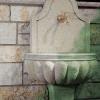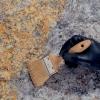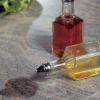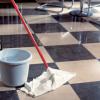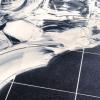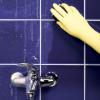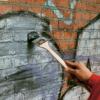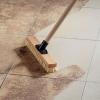Maintenance
Just after installation ...
Interior floors in general:
Before any operation it is indispensable to allow the newly laid slabs to dry.
A period of 3 to 6 months is needed to allow the humidity following installation to evaporate.
During this drying period it is advisable to clean using only a cloth soaked in clear water so as to avoid any "filling" of the material which would delay or block the evaporation of water.
The joints:
Make sure that the joints have been filled properly and that there are no cracks through which water could enter.
If the covering is particularly dirty after installation, it can be scrubbed using multi-purpose Lithofin cleaner.
For those who prefer shining floors, other maintenance techniques are available using natural or synthetic polishes. But these require more delicate handling.
Maintenance, cleaning and protection
Because of its hardness and almost zero porosity (0.24%), Belgian blue limestone has a particularly good resistance to stains, graffiti and environmental pressures. However, like all materials despite its many excellent qualities it still requires a minimum level of maintenance to enhance its magnificent patina.
Interior slabs
Maintenance with general purpose soap:
When the humidity arising from installation has disappeared, we recommend using a neutral household type soap in the form of flakes diluted in warm water. This soap should, however, be used in reasonable proportions (one handful in 10 litres of water) as excess soap will form an unsightly film on the surface of the covering.
Acidic maintenance products are obviously prohibited. Initially, the soap is not rinsed off to allow it to penetrate into the decorative layer of the tiles. The user must therefore sometimes exercise patience and remember that a natural stone evolves all its life, which is one of its charms.
One also finds on the market specific products for natural stone (for example those made by Lithofin). For the most part these products produce good results, provided that the manufacturer’s instructions are scrupulously respected and excessive doses are avoided.
Exterior slabs
To remove grease stains, after a barbecue for example, simply wait until it rains (remember that real Belgian Blue Limestone is not porous).
If necessary, dilute 2 spoons of ammonia in a bucket of water, wipe with a hard brush and the floor will be restored to its original appearance.
In a shaded environment (vegetation) do not hesitate to use bleach, while taking care not to damage the lawn.
In autumn and spring, cleaning with NON-RINSE general purpose soap will preserve the bluish grey appearance of the blue stone.
The K2R® stain remover for clothes completely dissolves grease, motor oil and candle stains and leaves no trace.
Maintenance of worktops
Belgian blue limestone has again become very fashionable in our kitchens. We need only think of the magnificent blue limestone tubs under the hand waterpumps of our ancestors. Nostalgia for the “good old days” and the relaxed rhythm of life they suggest are probably at the origin of the renewal of interest in Belgian blue limestone.
At the beginning unpleasant surprises may leave you perplexed: the stone may get scratched or become hideously eroded by acidic liquids. And yet how do you explain the fact that the old worktops have stayed so beautiful? Simply because the years have provided them with the patina that is their characteristic. To compensate for the absence of patina and to protect your worktop, your stonecutter/stone-mason will apply a protective treatment that you will have to reapply from time to time.
For everyday maintenance, clean the worktop using washing up liquid or simply wipe with a cloth soaked in a little vegetable oil.
Small holes
Small black stains/ holes may sometimes appear on the surface of floor tiles or small chips may become loose. This phenomenon is inherent in the structure of all limestone and does not signify a threat to the permanence of the material. If you look at the slabs of old buildings you will see that this phenomenon has always existed.
How do you restrict the appearance of small holes?
- Place a damp-proof membrane under the sealing coat.
- Do not soak the slabs before installation.
- Do not use a mortar that is too wet.
- Allow it dry well after installation.
- If possible wait a few days before making the joints.
- Do not allow the cleaning water to stagnate.
- Check the damp-proofness of the joints properly.
- Carefully follow our maintenance tips.
Renovation of blue limestone
In contrast to stones with a similar appearance, the mechanical and physical properties of which are not or only poorly known, and synthetic materials, our stone can always undergo a "facelift".
Please consult any of our distributors (stonecutters – stone-masons) or a company that specialises in renovation/restoration.
You can also refer to the large compendium of literature at the Scientific and Technical Construction Centre.
Anti-graffiti protection:
When one has invested in a building, and especially in a beautiful Belgian Blue limestone facade cladding, one is always disappointed to see unscrupulous people daring to deface such beautiful designs so barbarically. Luckily, as it is not porous, Belgian Blue limestone does not absorb paint and ink in its mass. Paint can therefore be easily removed with solvents. A light sanding will remove more stubborn stains. Preventive treatments are also available to facilitate the removal of stains.
There are two totally different treatment systems to protect Belgian Blue limestone facades from paint damage. The first consists of putting down a layer of polymers on the surface that will darken the stone (even if it has, initially, a light finish). This treatment is only applicable in a very few cases because it completely changes the appearance of the stone.
The other system consists of a treatment that does not modify its appearance. This can be carried out in a factory. The graffiti marks can then be removed simply using a thinner. Carrières du Hainaut recommends the use of Imperplex, produced by the company THIRY in Leuven.
More info: www.carrieresduhainaut.com
